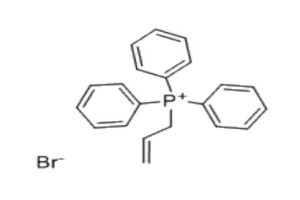
Allyltriphenylphosphonium Bromide (CAS No: 1560-54-9) is a versatile chemical compound widely used in organic synthesis and industrial applications. As a quaternary phosphonium salt, it plays a crucial role in phase-transfer catalysis and the Wittig reaction — key transformations in modern organic and pharmaceutical chemistry. Its unique structure and reactivity make it an indispensable reagent in laboratories and chemical industries worldwide.
Chemical Name: Allyltriphenylphosphonium Bromide
CAS Number: 1560-54-9
Molecular Formula: C21H20PBr
Molecular Weight: 399.27 g/mol
Appearance: White to off-white crystalline powder
Solubility: Soluble in polar solvents like ethanol, methanol, and water
This compound features a phosphonium cation bonded to an allyl group and three phenyl rings, providing excellent stability and controlled reactivity under various conditions.
One of the primary uses of Allyltriphenylphosphonium Bromide is in the Wittig reaction, a well-known method for synthesizing alkenes. It serves as a precursor to ylides, which react with aldehydes or ketones to form alkenes — a crucial step in producing fine chemicals, fragrances, and pharmaceutical intermediates.
This compound is widely used in organic synthesis for forming carbon–carbon double bonds. Its controlled reactivity and compatibility with diverse functional groups make it an essential reagent for academic and industrial chemists.
In some processes, Allyltriphenylphosphonium Bromide functions as a phase-transfer catalyst (PTC), enhancing the efficiency of reactions between immiscible phases such as water and organic solvents. This application is particularly useful in green chemistry, where reaction efficiency and waste reduction are prioritized.
It is also employed in polymer modification and surface functionalization due to its reactive allyl group. Researchers use it to introduce allyl functionalities into polymers, improving adhesion, flexibility, or cross-linking behavior.
In the pharmaceutical industry, CAS 1560-54-9 acts as a synthetic intermediate in the preparation of biologically active molecules and drug candidates. Its ability to form targeted double bonds makes it valuable in drug discovery and active ingredient synthesis.
The increasing focus on organic synthesis, drug discovery, and material innovation has driven global demand for Allyltriphenylphosphonium Bromide. Research institutions and pharmaceutical companies are major consumers due to its versatility in laboratory reactions.
Major suppliers of CAS 1560-54-9 are based in China, India, the United States, and Europe. These regions have robust chemical manufacturing capabilities and are continuously expanding their fine chemical production capacities.
The market for Allyltriphenylphosphonium Bromide is expected to witness steady growth over the next decade. Increased adoption in specialty chemicals, academic research, and industrial synthesis is fueling the expansion. Additionally, the rise of green and sustainable chemistry approaches enhances the demand for efficient reagents like this compound.
While Allyltriphenylphosphonium Bromide is generally stable, it should be handled with standard laboratory precautions:
Store in a cool, dry place away from moisture.
Use protective gloves, goggles, and clothing when handling.
Avoid inhalation or direct skin contact.
Dispose of waste according to local environmental regulations.
Allyltriphenylphosphonium Bromide (CAS No: 1560-54-9) continues to be a valuable reagent in the fields of organic chemistry, pharmaceuticals, and materials science. Its effectiveness in carbon–carbon bond formation and role as a phase-transfer catalyst make it indispensable in both research and industry. With the growing demand for efficient and sustainable chemical processes, this compound is set to play an even greater role in shaping the future of synthetic chemistry.